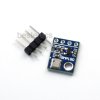Hi All.
I am currently constructing a wind tunnel with some friends and we'd like a means of measuring airspeed within the wind tunnel.
Ideas include:
- Pitot tube with differential pressure sensors
- Load cell to measure force and convert to airspeed
The sensor/cell will be hooked up to an arduino uno and programmed to display airspeed on a pc or lcd. Price isn't really an issue but I thought something like this would suffice:
The sensor must be able to handle wind-speeds of up to 45m/s.
Advice would be greatly appreciated - this project is to be displayed at an engineering show in 5 weeks!!
Many thanks
Tom
I am currently constructing a wind tunnel with some friends and we'd like a means of measuring airspeed within the wind tunnel.
Ideas include:
- Pitot tube with differential pressure sensors
- Load cell to measure force and convert to airspeed
The sensor/cell will be hooked up to an arduino uno and programmed to display airspeed on a pc or lcd. Price isn't really an issue but I thought something like this would suffice:
The sensor must be able to handle wind-speeds of up to 45m/s.
Advice would be greatly appreciated - this project is to be displayed at an engineering show in 5 weeks!!
Many thanks
Tom

